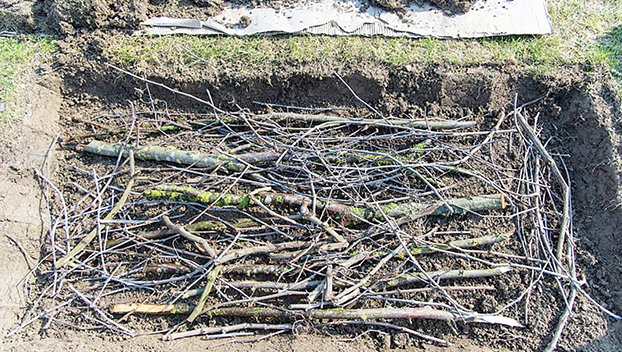MASTER GARDENER — Understand the Hügelkultur Gardening method (Part 1 of 3)
Published 12:04 am Wednesday, February 15, 2023

- The foundation of a hügelkultur raised bed begins by selecting a sunny location. Add logs and branches to the trench. (Courtesy of the Farmer’s Almanac).
|
Getting your Trinity Audio player ready...
|
We seem to be stuck in a somewhat dreary weather “holding” pattern of sorts, it’s SETX normal for late winter.
Afterwards, the “icky” days (clearly not a meteorological term) are followed by a couple days of balmy, spring-like days, where temperatures approach 80 degrees or so.
Our “environmental shifts” are confusing as the seasons transition from one to another, sending mixed signals to trees, plants and yes-even gardeners. Most gardeners are ready for spring to return (so am I), and fortunately, we don’t have too much longer to wait. You’ll want to continue preparing vegetable and flower beds for planting, as now is a good time to top-dress planting areas with 1 or 2-inches of composted manure.
Today’s topic is part one of a three-part series featuring a gardening technique which has been used in Germany and many Eastern European countries for several hundred years, though the word “hügelkultur” (pronounced “who-gull culture”), was not introduced until 1962, referenced in a German gardening booklet written by Hermann Andrä.
Hügelkultur’s literal translation means “hill culture” or its also known as “mound culture.” OK gardeners, this now completes the history portion of today’s topic-side note: sometimes, curious, and inquiring minds want to know!
SO, is building a hügelkultur raised bed right for you? Speaking from personal experience, this is the method I utilized when building eight, large, raised beds more than a year ago, during the month of August (guarantee I wasn’t complaining about cold weather)! Using this method of filling raised beds employs environmental conservation, initiates carbon sequestration, and provides financial benefits as well, so what’s not to like? Well, let’s “dig deeper” (pun intended-sorry, I couldn’t help myself) and answer a few questions that may come to mind, such as exactly is hügelkultur? Is it a benefit to raised garden beds? Are there drawbacks to using the method?
Hügelkultur, initially was a trench, long and narrow, filled with logs left to decay. The logs were “mounded over” with soil, making a lengthy, tall vertical structure.
The large structure increases the amount of available surface planting area, more so than a typical horizontal garden provides. Placing logs into the beds provides bulk, which decays gradually over several years yet can be detected as the mound slowly sinks over time. The mound becomes a micro-ecosystem.
A hügelkultur raised bed is an excellent way to utilize large limbs and branches, as well as other yard debris to make up to half of the material needed to fill a raised bed.
Numerous other materials such as grass clippings, leaves, hay, rice hulls, and paperboard boxes can be used to fill in the areas between the tree limbs and logs, speeding the decomposition process.
For the final layers, add a mixture of garden soil, leaf mold, composted livestock manure, and compost. This gardening technique reduces the materials needed to fill a garden bed, provides gardeners an avenue to reduce lawn and garden, or pasture debris responsibly without burning materials or adding to a landfill, which saves money as this technique reduces the amount of soil needed to fill each raised bed by half!
So, what are the benefits of building a hügelkultur garden bed you ask?
In my experience, some of the benefits include:
- They are cost-effective and efficient to build.
- Provide gardeners an outlet to utilize yard debris and other materials, i.e…branches, small logs, untreated scrap lumber, woody shrub limbs, leaf litter, grass clippings, hay, paperboard boxes, etc.
- Increase the organic matter availability within each bed while materials slowly decompose.
- Reduction in soil volume needed to build raised beds.
- Soil water retention slowly increases, initially insignificant until wood components begin to decompose.
The hügelkultur method utilized in a raised bed setting is not miraculous when initially installed but the benefits become pronounced over time. Note that using nitrogen-rich “green wastes,” such as grass clippings as filler around the limbs and branches mitigate nitrogen theft by decomposing wood components.
Naturally, nitrogen is carried away during watering events but can easily be replaced organically or through fertilizer application.
To have all your gardening questions answered or for more detailed information, email Texas Certified Master Gardener John Green of Orange County Master Gardeners at jongreene57@gmail.com or contact the Orange County Master Gardeners Helpline 409-882-7010 or visit /txmg.org/orange, Facebook: Orange County Texas Master Gardeners Association or email extension@co.orange.tx.us.





